Organisational Change Approaches in HRM 3008: University Report
VerifiedAdded on 2020/04/01
|12
|4088
|41
Report
AI Summary
This report, prepared for the HRM 3008 Organisational Change module at the University of Northampton, explores three key approaches to organisational change. The first approach examines the use of power, specifically legitimate and expert power, to facilitate change programs, using the O2 case study as an example. It analyzes the strengths and weaknesses of this approach, emphasizing participative leadership. The second approach focuses on organisational communication strategies in managing a workforce during mergers and acquisitions, highlighting the importance of open communication and the use of tools like enterprise resource planning and customer relationship management software. The report also discusses the application of communication strategies and their strengths. The third approach, though mentioned, is not fully developed in the provided text. The report concludes with action plans for each approach, emphasizing the importance of strategic commitment, medium selection, and establishing common patterns to positively impact employees during organisational change. The report references various theories and case studies to support its analysis and recommendations.
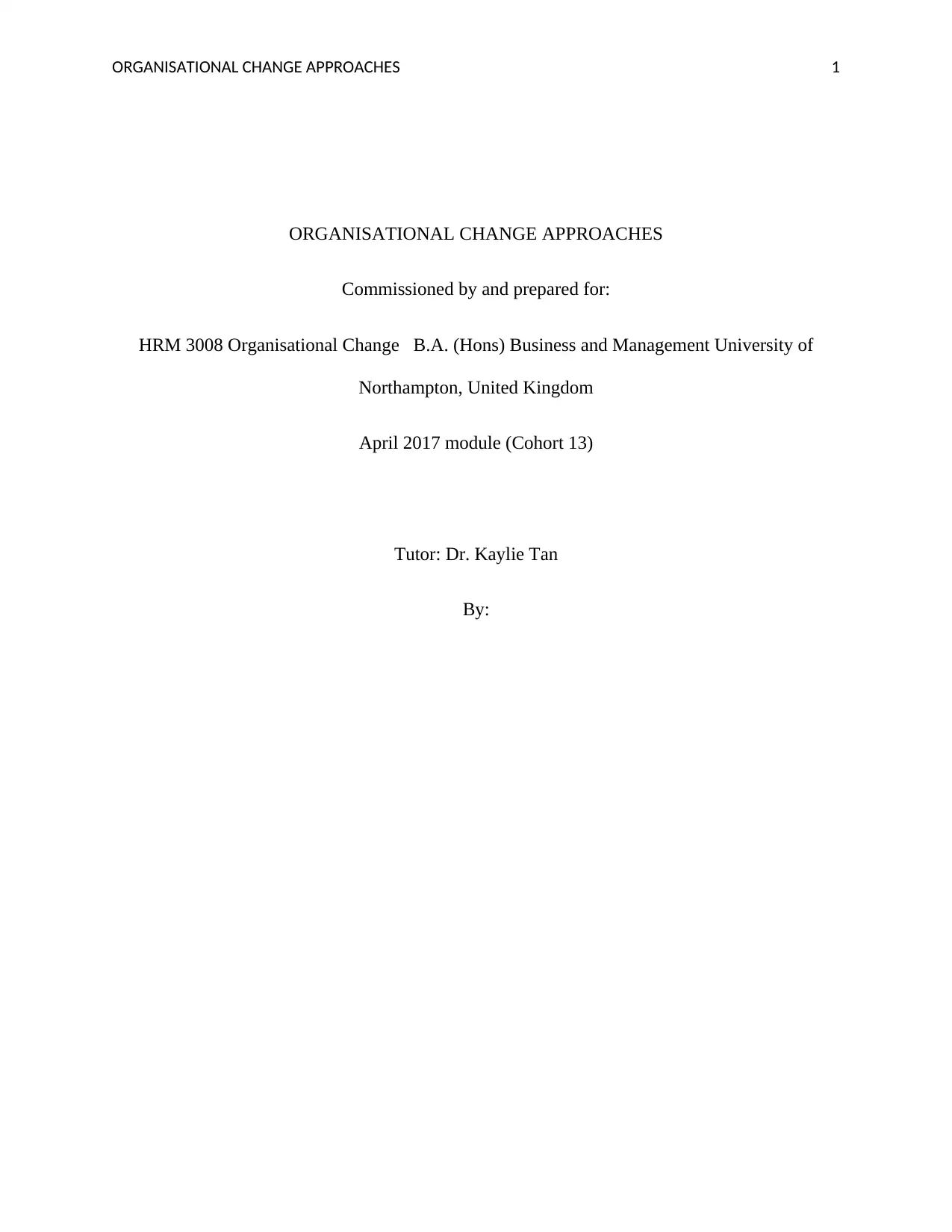
ORGANISATIONAL CHANGE APPROACHES 1
ORGANISATIONAL CHANGE APPROACHES
Commissioned by and prepared for:
HRM 3008 Organisational Change B.A. (Hons) Business and Management University of
Northampton, United Kingdom
April 2017 module (Cohort 13)
Tutor: Dr. Kaylie Tan
By:
ORGANISATIONAL CHANGE APPROACHES
Commissioned by and prepared for:
HRM 3008 Organisational Change B.A. (Hons) Business and Management University of
Northampton, United Kingdom
April 2017 module (Cohort 13)
Tutor: Dr. Kaylie Tan
By:
Paraphrase This Document
Need a fresh take? Get an instant paraphrase of this document with our AI Paraphraser
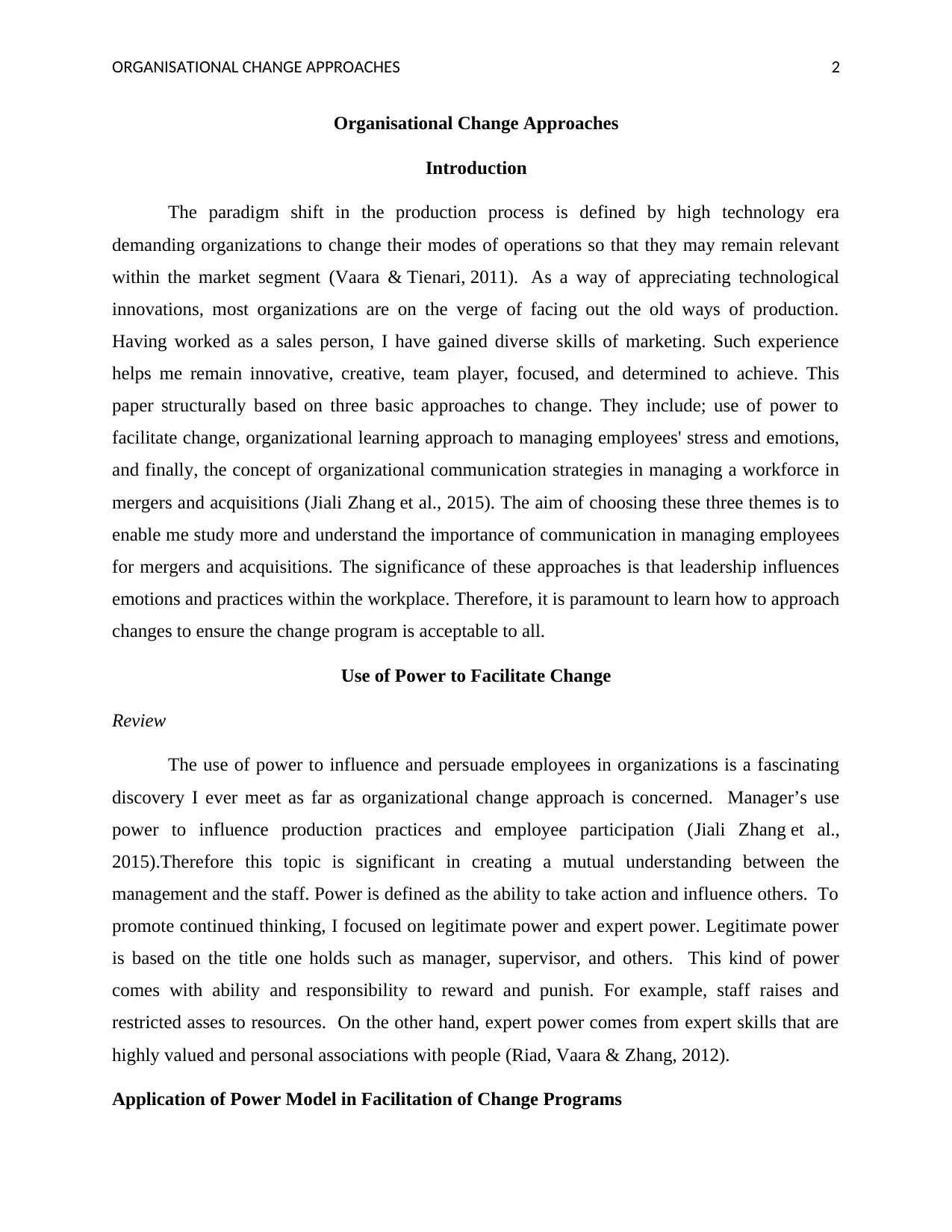
ORGANISATIONAL CHANGE APPROACHES 2
Organisational Change Approaches
Introduction
The paradigm shift in the production process is defined by high technology era
demanding organizations to change their modes of operations so that they may remain relevant
within the market segment (Vaara & Tienari, 2011). As a way of appreciating technological
innovations, most organizations are on the verge of facing out the old ways of production.
Having worked as a sales person, I have gained diverse skills of marketing. Such experience
helps me remain innovative, creative, team player, focused, and determined to achieve. This
paper structurally based on three basic approaches to change. They include; use of power to
facilitate change, organizational learning approach to managing employees' stress and emotions,
and finally, the concept of organizational communication strategies in managing a workforce in
mergers and acquisitions (Jiali Zhang et al., 2015). The aim of choosing these three themes is to
enable me study more and understand the importance of communication in managing employees
for mergers and acquisitions. The significance of these approaches is that leadership influences
emotions and practices within the workplace. Therefore, it is paramount to learn how to approach
changes to ensure the change program is acceptable to all.
Use of Power to Facilitate Change
Review
The use of power to influence and persuade employees in organizations is a fascinating
discovery I ever meet as far as organizational change approach is concerned. Manager’s use
power to influence production practices and employee participation (Jiali Zhang et al.,
2015).Therefore this topic is significant in creating a mutual understanding between the
management and the staff. Power is defined as the ability to take action and influence others. To
promote continued thinking, I focused on legitimate power and expert power. Legitimate power
is based on the title one holds such as manager, supervisor, and others. This kind of power
comes with ability and responsibility to reward and punish. For example, staff raises and
restricted asses to resources. On the other hand, expert power comes from expert skills that are
highly valued and personal associations with people (Riad, Vaara & Zhang, 2012).
Application of Power Model in Facilitation of Change Programs
Organisational Change Approaches
Introduction
The paradigm shift in the production process is defined by high technology era
demanding organizations to change their modes of operations so that they may remain relevant
within the market segment (Vaara & Tienari, 2011). As a way of appreciating technological
innovations, most organizations are on the verge of facing out the old ways of production.
Having worked as a sales person, I have gained diverse skills of marketing. Such experience
helps me remain innovative, creative, team player, focused, and determined to achieve. This
paper structurally based on three basic approaches to change. They include; use of power to
facilitate change, organizational learning approach to managing employees' stress and emotions,
and finally, the concept of organizational communication strategies in managing a workforce in
mergers and acquisitions (Jiali Zhang et al., 2015). The aim of choosing these three themes is to
enable me study more and understand the importance of communication in managing employees
for mergers and acquisitions. The significance of these approaches is that leadership influences
emotions and practices within the workplace. Therefore, it is paramount to learn how to approach
changes to ensure the change program is acceptable to all.
Use of Power to Facilitate Change
Review
The use of power to influence and persuade employees in organizations is a fascinating
discovery I ever meet as far as organizational change approach is concerned. Manager’s use
power to influence production practices and employee participation (Jiali Zhang et al.,
2015).Therefore this topic is significant in creating a mutual understanding between the
management and the staff. Power is defined as the ability to take action and influence others. To
promote continued thinking, I focused on legitimate power and expert power. Legitimate power
is based on the title one holds such as manager, supervisor, and others. This kind of power
comes with ability and responsibility to reward and punish. For example, staff raises and
restricted asses to resources. On the other hand, expert power comes from expert skills that are
highly valued and personal associations with people (Riad, Vaara & Zhang, 2012).
Application of Power Model in Facilitation of Change Programs
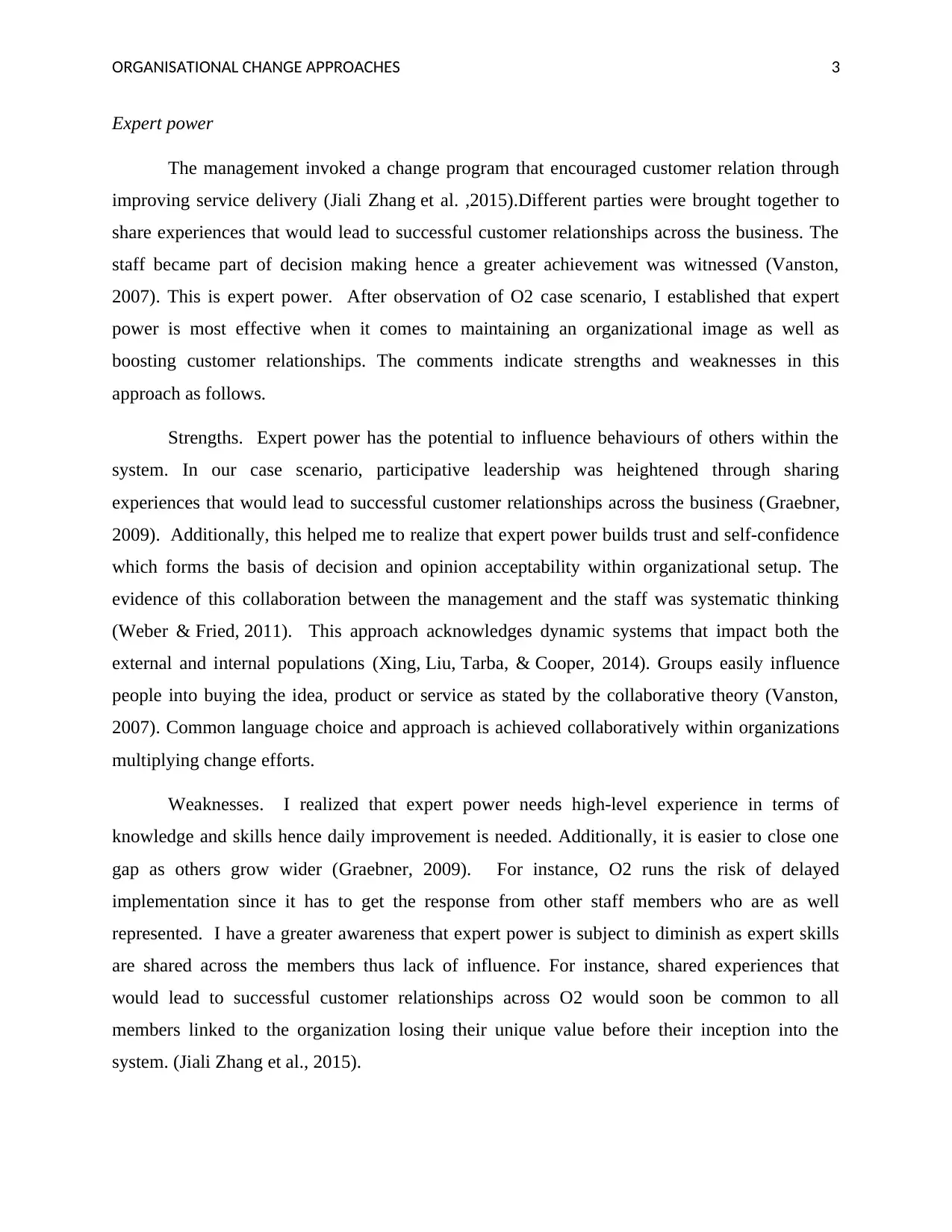
ORGANISATIONAL CHANGE APPROACHES 3
Expert power
The management invoked a change program that encouraged customer relation through
improving service delivery (Jiali Zhang et al. ,2015).Different parties were brought together to
share experiences that would lead to successful customer relationships across the business. The
staff became part of decision making hence a greater achievement was witnessed (Vanston,
2007). This is expert power. After observation of O2 case scenario, I established that expert
power is most effective when it comes to maintaining an organizational image as well as
boosting customer relationships. The comments indicate strengths and weaknesses in this
approach as follows.
Strengths. Expert power has the potential to influence behaviours of others within the
system. In our case scenario, participative leadership was heightened through sharing
experiences that would lead to successful customer relationships across the business (Graebner,
2009). Additionally, this helped me to realize that expert power builds trust and self-confidence
which forms the basis of decision and opinion acceptability within organizational setup. The
evidence of this collaboration between the management and the staff was systematic thinking
(Weber & Fried, 2011). This approach acknowledges dynamic systems that impact both the
external and internal populations (Xing, Liu, Tarba, & Cooper, 2014). Groups easily influence
people into buying the idea, product or service as stated by the collaborative theory (Vanston,
2007). Common language choice and approach is achieved collaboratively within organizations
multiplying change efforts.
Weaknesses. I realized that expert power needs high-level experience in terms of
knowledge and skills hence daily improvement is needed. Additionally, it is easier to close one
gap as others grow wider (Graebner, 2009). For instance, O2 runs the risk of delayed
implementation since it has to get the response from other staff members who are as well
represented. I have a greater awareness that expert power is subject to diminish as expert skills
are shared across the members thus lack of influence. For instance, shared experiences that
would lead to successful customer relationships across O2 would soon be common to all
members linked to the organization losing their unique value before their inception into the
system. (Jiali Zhang et al., 2015).
Expert power
The management invoked a change program that encouraged customer relation through
improving service delivery (Jiali Zhang et al. ,2015).Different parties were brought together to
share experiences that would lead to successful customer relationships across the business. The
staff became part of decision making hence a greater achievement was witnessed (Vanston,
2007). This is expert power. After observation of O2 case scenario, I established that expert
power is most effective when it comes to maintaining an organizational image as well as
boosting customer relationships. The comments indicate strengths and weaknesses in this
approach as follows.
Strengths. Expert power has the potential to influence behaviours of others within the
system. In our case scenario, participative leadership was heightened through sharing
experiences that would lead to successful customer relationships across the business (Graebner,
2009). Additionally, this helped me to realize that expert power builds trust and self-confidence
which forms the basis of decision and opinion acceptability within organizational setup. The
evidence of this collaboration between the management and the staff was systematic thinking
(Weber & Fried, 2011). This approach acknowledges dynamic systems that impact both the
external and internal populations (Xing, Liu, Tarba, & Cooper, 2014). Groups easily influence
people into buying the idea, product or service as stated by the collaborative theory (Vanston,
2007). Common language choice and approach is achieved collaboratively within organizations
multiplying change efforts.
Weaknesses. I realized that expert power needs high-level experience in terms of
knowledge and skills hence daily improvement is needed. Additionally, it is easier to close one
gap as others grow wider (Graebner, 2009). For instance, O2 runs the risk of delayed
implementation since it has to get the response from other staff members who are as well
represented. I have a greater awareness that expert power is subject to diminish as expert skills
are shared across the members thus lack of influence. For instance, shared experiences that
would lead to successful customer relationships across O2 would soon be common to all
members linked to the organization losing their unique value before their inception into the
system. (Jiali Zhang et al., 2015).
⊘ This is a preview!⊘
Do you want full access?
Subscribe today to unlock all pages.

Trusted by 1+ million students worldwide
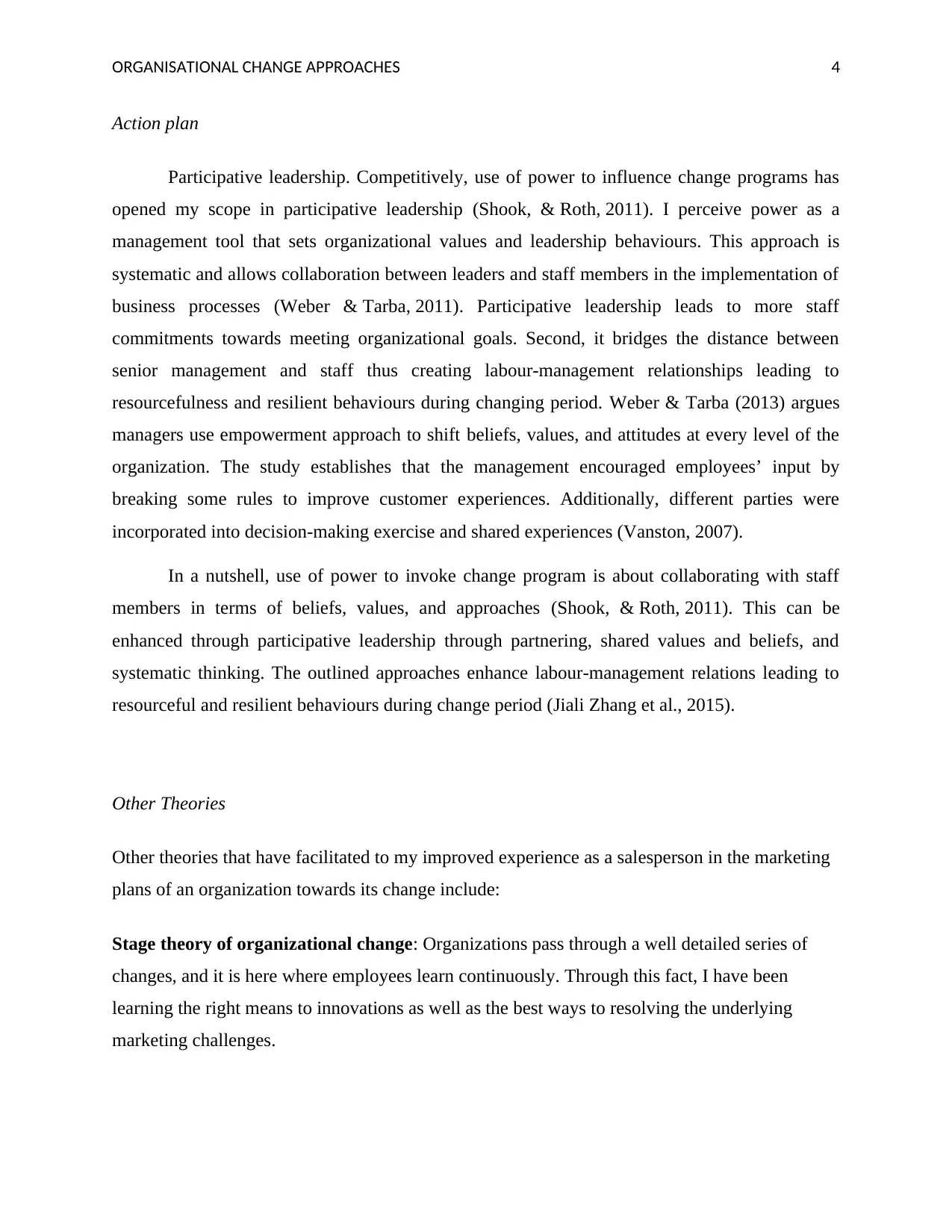
ORGANISATIONAL CHANGE APPROACHES 4
Action plan
Participative leadership. Competitively, use of power to influence change programs has
opened my scope in participative leadership (Shook, & Roth, 2011). I perceive power as a
management tool that sets organizational values and leadership behaviours. This approach is
systematic and allows collaboration between leaders and staff members in the implementation of
business processes (Weber & Tarba, 2011). Participative leadership leads to more staff
commitments towards meeting organizational goals. Second, it bridges the distance between
senior management and staff thus creating labour-management relationships leading to
resourcefulness and resilient behaviours during changing period. Weber & Tarba (2013) argues
managers use empowerment approach to shift beliefs, values, and attitudes at every level of the
organization. The study establishes that the management encouraged employees’ input by
breaking some rules to improve customer experiences. Additionally, different parties were
incorporated into decision-making exercise and shared experiences (Vanston, 2007).
In a nutshell, use of power to invoke change program is about collaborating with staff
members in terms of beliefs, values, and approaches (Shook, & Roth, 2011). This can be
enhanced through participative leadership through partnering, shared values and beliefs, and
systematic thinking. The outlined approaches enhance labour-management relations leading to
resourceful and resilient behaviours during change period (Jiali Zhang et al., 2015).
Other Theories
Other theories that have facilitated to my improved experience as a salesperson in the marketing
plans of an organization towards its change include:
Stage theory of organizational change: Organizations pass through a well detailed series of
changes, and it is here where employees learn continuously. Through this fact, I have been
learning the right means to innovations as well as the best ways to resolving the underlying
marketing challenges.
Action plan
Participative leadership. Competitively, use of power to influence change programs has
opened my scope in participative leadership (Shook, & Roth, 2011). I perceive power as a
management tool that sets organizational values and leadership behaviours. This approach is
systematic and allows collaboration between leaders and staff members in the implementation of
business processes (Weber & Tarba, 2011). Participative leadership leads to more staff
commitments towards meeting organizational goals. Second, it bridges the distance between
senior management and staff thus creating labour-management relationships leading to
resourcefulness and resilient behaviours during changing period. Weber & Tarba (2013) argues
managers use empowerment approach to shift beliefs, values, and attitudes at every level of the
organization. The study establishes that the management encouraged employees’ input by
breaking some rules to improve customer experiences. Additionally, different parties were
incorporated into decision-making exercise and shared experiences (Vanston, 2007).
In a nutshell, use of power to invoke change program is about collaborating with staff
members in terms of beliefs, values, and approaches (Shook, & Roth, 2011). This can be
enhanced through participative leadership through partnering, shared values and beliefs, and
systematic thinking. The outlined approaches enhance labour-management relations leading to
resourceful and resilient behaviours during change period (Jiali Zhang et al., 2015).
Other Theories
Other theories that have facilitated to my improved experience as a salesperson in the marketing
plans of an organization towards its change include:
Stage theory of organizational change: Organizations pass through a well detailed series of
changes, and it is here where employees learn continuously. Through this fact, I have been
learning the right means to innovations as well as the best ways to resolving the underlying
marketing challenges.
Paraphrase This Document
Need a fresh take? Get an instant paraphrase of this document with our AI Paraphraser
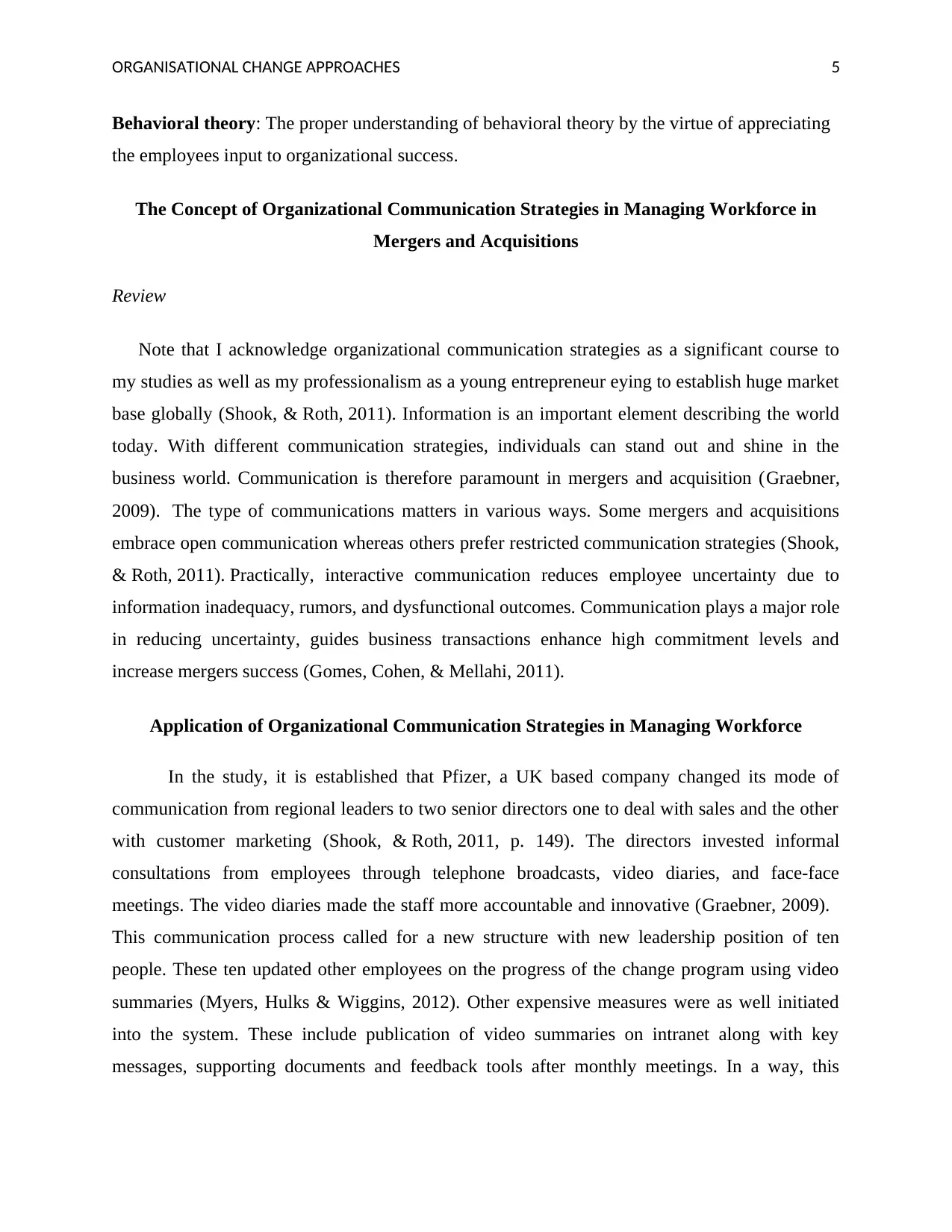
ORGANISATIONAL CHANGE APPROACHES 5
Behavioral theory: The proper understanding of behavioral theory by the virtue of appreciating
the employees input to organizational success.
The Concept of Organizational Communication Strategies in Managing Workforce in
Mergers and Acquisitions
Review
Note that I acknowledge organizational communication strategies as a significant course to
my studies as well as my professionalism as a young entrepreneur eying to establish huge market
base globally (Shook, & Roth, 2011). Information is an important element describing the world
today. With different communication strategies, individuals can stand out and shine in the
business world. Communication is therefore paramount in mergers and acquisition (Graebner,
2009). The type of communications matters in various ways. Some mergers and acquisitions
embrace open communication whereas others prefer restricted communication strategies (Shook,
& Roth, 2011). Practically, interactive communication reduces employee uncertainty due to
information inadequacy, rumors, and dysfunctional outcomes. Communication plays a major role
in reducing uncertainty, guides business transactions enhance high commitment levels and
increase mergers success (Gomes, Cohen, & Mellahi, 2011).
Application of Organizational Communication Strategies in Managing Workforce
In the study, it is established that Pfizer, a UK based company changed its mode of
communication from regional leaders to two senior directors one to deal with sales and the other
with customer marketing (Shook, & Roth, 2011, p. 149). The directors invested informal
consultations from employees through telephone broadcasts, video diaries, and face-face
meetings. The video diaries made the staff more accountable and innovative (Graebner, 2009).
This communication process called for a new structure with new leadership position of ten
people. These ten updated other employees on the progress of the change program using video
summaries (Myers, Hulks & Wiggins, 2012). Other expensive measures were as well initiated
into the system. These include publication of video summaries on intranet along with key
messages, supporting documents and feedback tools after monthly meetings. In a way, this
Behavioral theory: The proper understanding of behavioral theory by the virtue of appreciating
the employees input to organizational success.
The Concept of Organizational Communication Strategies in Managing Workforce in
Mergers and Acquisitions
Review
Note that I acknowledge organizational communication strategies as a significant course to
my studies as well as my professionalism as a young entrepreneur eying to establish huge market
base globally (Shook, & Roth, 2011). Information is an important element describing the world
today. With different communication strategies, individuals can stand out and shine in the
business world. Communication is therefore paramount in mergers and acquisition (Graebner,
2009). The type of communications matters in various ways. Some mergers and acquisitions
embrace open communication whereas others prefer restricted communication strategies (Shook,
& Roth, 2011). Practically, interactive communication reduces employee uncertainty due to
information inadequacy, rumors, and dysfunctional outcomes. Communication plays a major role
in reducing uncertainty, guides business transactions enhance high commitment levels and
increase mergers success (Gomes, Cohen, & Mellahi, 2011).
Application of Organizational Communication Strategies in Managing Workforce
In the study, it is established that Pfizer, a UK based company changed its mode of
communication from regional leaders to two senior directors one to deal with sales and the other
with customer marketing (Shook, & Roth, 2011, p. 149). The directors invested informal
consultations from employees through telephone broadcasts, video diaries, and face-face
meetings. The video diaries made the staff more accountable and innovative (Graebner, 2009).
This communication process called for a new structure with new leadership position of ten
people. These ten updated other employees on the progress of the change program using video
summaries (Myers, Hulks & Wiggins, 2012). Other expensive measures were as well initiated
into the system. These include publication of video summaries on intranet along with key
messages, supporting documents and feedback tools after monthly meetings. In a way, this
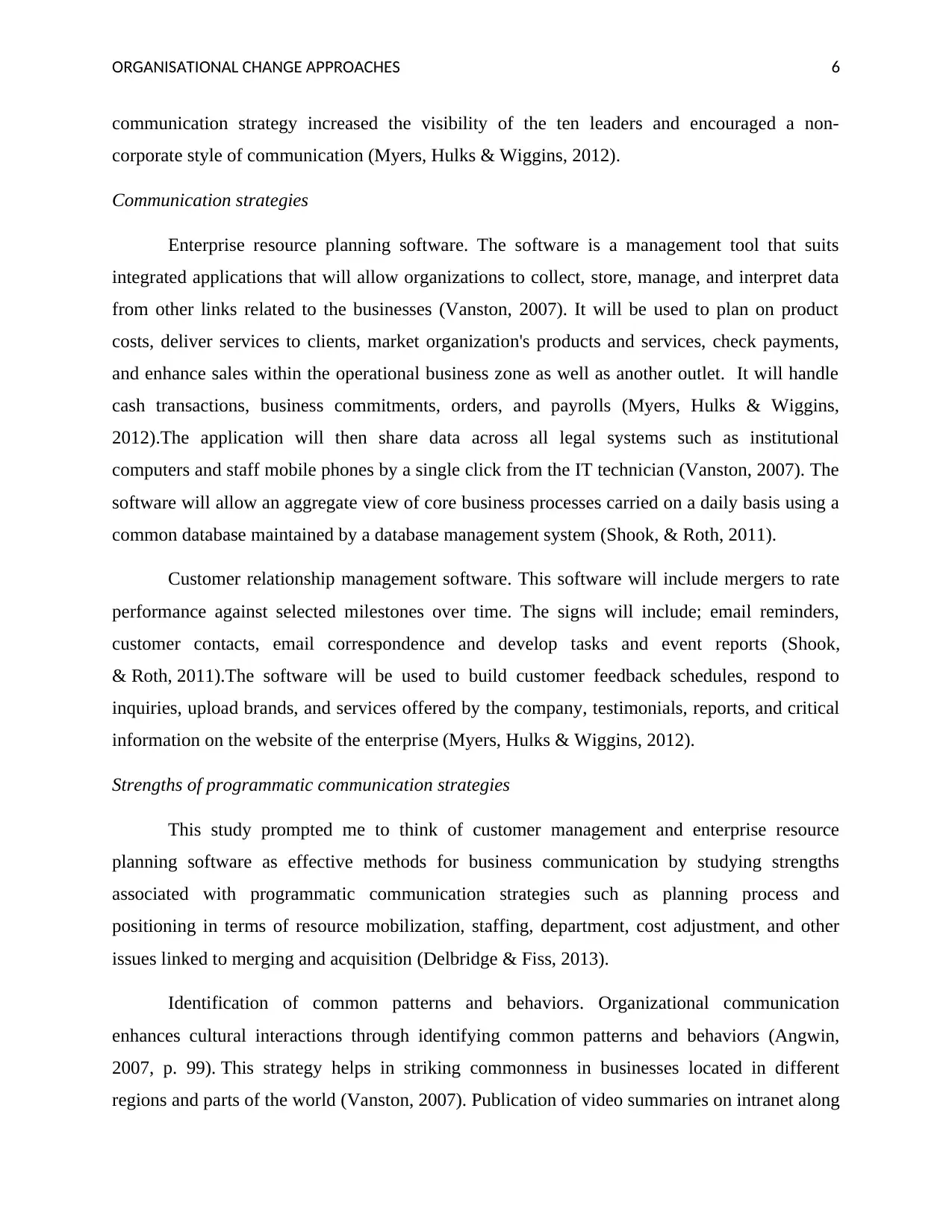
ORGANISATIONAL CHANGE APPROACHES 6
communication strategy increased the visibility of the ten leaders and encouraged a non-
corporate style of communication (Myers, Hulks & Wiggins, 2012).
Communication strategies
Enterprise resource planning software. The software is a management tool that suits
integrated applications that will allow organizations to collect, store, manage, and interpret data
from other links related to the businesses (Vanston, 2007). It will be used to plan on product
costs, deliver services to clients, market organization's products and services, check payments,
and enhance sales within the operational business zone as well as another outlet. It will handle
cash transactions, business commitments, orders, and payrolls (Myers, Hulks & Wiggins,
2012).The application will then share data across all legal systems such as institutional
computers and staff mobile phones by a single click from the IT technician (Vanston, 2007). The
software will allow an aggregate view of core business processes carried on a daily basis using a
common database maintained by a database management system (Shook, & Roth, 2011).
Customer relationship management software. This software will include mergers to rate
performance against selected milestones over time. The signs will include; email reminders,
customer contacts, email correspondence and develop tasks and event reports (Shook,
& Roth, 2011).The software will be used to build customer feedback schedules, respond to
inquiries, upload brands, and services offered by the company, testimonials, reports, and critical
information on the website of the enterprise (Myers, Hulks & Wiggins, 2012).
Strengths of programmatic communication strategies
This study prompted me to think of customer management and enterprise resource
planning software as effective methods for business communication by studying strengths
associated with programmatic communication strategies such as planning process and
positioning in terms of resource mobilization, staffing, department, cost adjustment, and other
issues linked to merging and acquisition (Delbridge & Fiss, 2013).
Identification of common patterns and behaviors. Organizational communication
enhances cultural interactions through identifying common patterns and behaviors (Angwin,
2007, p. 99). This strategy helps in striking commonness in businesses located in different
regions and parts of the world (Vanston, 2007). Publication of video summaries on intranet along
communication strategy increased the visibility of the ten leaders and encouraged a non-
corporate style of communication (Myers, Hulks & Wiggins, 2012).
Communication strategies
Enterprise resource planning software. The software is a management tool that suits
integrated applications that will allow organizations to collect, store, manage, and interpret data
from other links related to the businesses (Vanston, 2007). It will be used to plan on product
costs, deliver services to clients, market organization's products and services, check payments,
and enhance sales within the operational business zone as well as another outlet. It will handle
cash transactions, business commitments, orders, and payrolls (Myers, Hulks & Wiggins,
2012).The application will then share data across all legal systems such as institutional
computers and staff mobile phones by a single click from the IT technician (Vanston, 2007). The
software will allow an aggregate view of core business processes carried on a daily basis using a
common database maintained by a database management system (Shook, & Roth, 2011).
Customer relationship management software. This software will include mergers to rate
performance against selected milestones over time. The signs will include; email reminders,
customer contacts, email correspondence and develop tasks and event reports (Shook,
& Roth, 2011).The software will be used to build customer feedback schedules, respond to
inquiries, upload brands, and services offered by the company, testimonials, reports, and critical
information on the website of the enterprise (Myers, Hulks & Wiggins, 2012).
Strengths of programmatic communication strategies
This study prompted me to think of customer management and enterprise resource
planning software as effective methods for business communication by studying strengths
associated with programmatic communication strategies such as planning process and
positioning in terms of resource mobilization, staffing, department, cost adjustment, and other
issues linked to merging and acquisition (Delbridge & Fiss, 2013).
Identification of common patterns and behaviors. Organizational communication
enhances cultural interactions through identifying common patterns and behaviors (Angwin,
2007, p. 99). This strategy helps in striking commonness in businesses located in different
regions and parts of the world (Vanston, 2007). Publication of video summaries on intranet along
⊘ This is a preview!⊘
Do you want full access?
Subscribe today to unlock all pages.

Trusted by 1+ million students worldwide
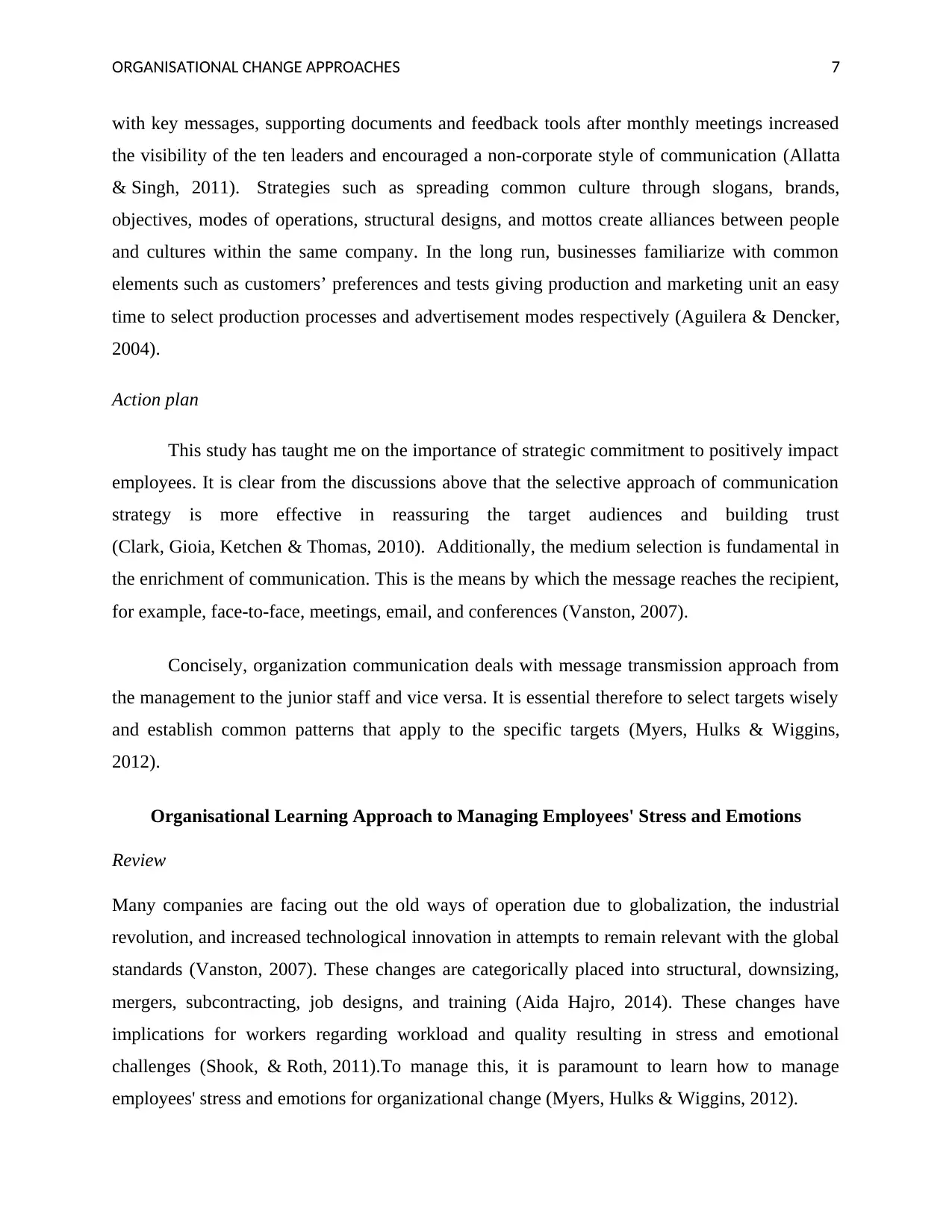
ORGANISATIONAL CHANGE APPROACHES 7
with key messages, supporting documents and feedback tools after monthly meetings increased
the visibility of the ten leaders and encouraged a non-corporate style of communication (Allatta
& Singh, 2011). Strategies such as spreading common culture through slogans, brands,
objectives, modes of operations, structural designs, and mottos create alliances between people
and cultures within the same company. In the long run, businesses familiarize with common
elements such as customers’ preferences and tests giving production and marketing unit an easy
time to select production processes and advertisement modes respectively (Aguilera & Dencker,
2004).
Action plan
This study has taught me on the importance of strategic commitment to positively impact
employees. It is clear from the discussions above that the selective approach of communication
strategy is more effective in reassuring the target audiences and building trust
(Clark, Gioia, Ketchen & Thomas, 2010). Additionally, the medium selection is fundamental in
the enrichment of communication. This is the means by which the message reaches the recipient,
for example, face-to-face, meetings, email, and conferences (Vanston, 2007).
Concisely, organization communication deals with message transmission approach from
the management to the junior staff and vice versa. It is essential therefore to select targets wisely
and establish common patterns that apply to the specific targets (Myers, Hulks & Wiggins,
2012).
Organisational Learning Approach to Managing Employees' Stress and Emotions
Review
Many companies are facing out the old ways of operation due to globalization, the industrial
revolution, and increased technological innovation in attempts to remain relevant with the global
standards (Vanston, 2007). These changes are categorically placed into structural, downsizing,
mergers, subcontracting, job designs, and training (Aida Hajro, 2014). These changes have
implications for workers regarding workload and quality resulting in stress and emotional
challenges (Shook, & Roth, 2011).To manage this, it is paramount to learn how to manage
employees' stress and emotions for organizational change (Myers, Hulks & Wiggins, 2012).
with key messages, supporting documents and feedback tools after monthly meetings increased
the visibility of the ten leaders and encouraged a non-corporate style of communication (Allatta
& Singh, 2011). Strategies such as spreading common culture through slogans, brands,
objectives, modes of operations, structural designs, and mottos create alliances between people
and cultures within the same company. In the long run, businesses familiarize with common
elements such as customers’ preferences and tests giving production and marketing unit an easy
time to select production processes and advertisement modes respectively (Aguilera & Dencker,
2004).
Action plan
This study has taught me on the importance of strategic commitment to positively impact
employees. It is clear from the discussions above that the selective approach of communication
strategy is more effective in reassuring the target audiences and building trust
(Clark, Gioia, Ketchen & Thomas, 2010). Additionally, the medium selection is fundamental in
the enrichment of communication. This is the means by which the message reaches the recipient,
for example, face-to-face, meetings, email, and conferences (Vanston, 2007).
Concisely, organization communication deals with message transmission approach from
the management to the junior staff and vice versa. It is essential therefore to select targets wisely
and establish common patterns that apply to the specific targets (Myers, Hulks & Wiggins,
2012).
Organisational Learning Approach to Managing Employees' Stress and Emotions
Review
Many companies are facing out the old ways of operation due to globalization, the industrial
revolution, and increased technological innovation in attempts to remain relevant with the global
standards (Vanston, 2007). These changes are categorically placed into structural, downsizing,
mergers, subcontracting, job designs, and training (Aida Hajro, 2014). These changes have
implications for workers regarding workload and quality resulting in stress and emotional
challenges (Shook, & Roth, 2011).To manage this, it is paramount to learn how to manage
employees' stress and emotions for organizational change (Myers, Hulks & Wiggins, 2012).
Paraphrase This Document
Need a fresh take? Get an instant paraphrase of this document with our AI Paraphraser
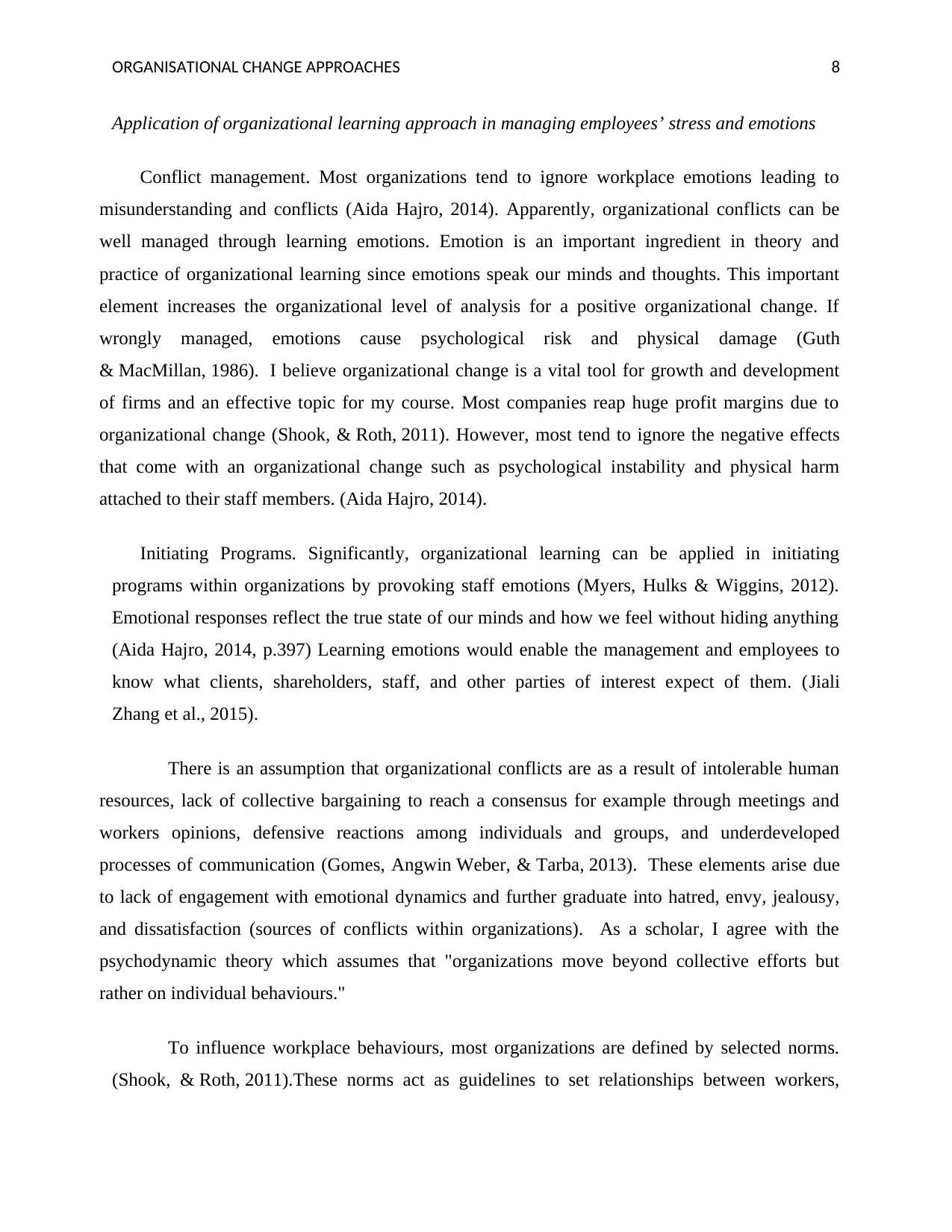
ORGANISATIONAL CHANGE APPROACHES 8
Application of organizational learning approach in managing employees’ stress and emotions
Conflict management. Most organizations tend to ignore workplace emotions leading to
misunderstanding and conflicts (Aida Hajro, 2014). Apparently, organizational conflicts can be
well managed through learning emotions. Emotion is an important ingredient in theory and
practice of organizational learning since emotions speak our minds and thoughts. This important
element increases the organizational level of analysis for a positive organizational change. If
wrongly managed, emotions cause psychological risk and physical damage (Guth
& MacMillan, 1986). I believe organizational change is a vital tool for growth and development
of firms and an effective topic for my course. Most companies reap huge profit margins due to
organizational change (Shook, & Roth, 2011). However, most tend to ignore the negative effects
that come with an organizational change such as psychological instability and physical harm
attached to their staff members. (Aida Hajro, 2014).
Initiating Programs. Significantly, organizational learning can be applied in initiating
programs within organizations by provoking staff emotions (Myers, Hulks & Wiggins, 2012).
Emotional responses reflect the true state of our minds and how we feel without hiding anything
(Aida Hajro, 2014, p.397) Learning emotions would enable the management and employees to
know what clients, shareholders, staff, and other parties of interest expect of them. (Jiali
Zhang et al., 2015).
There is an assumption that organizational conflicts are as a result of intolerable human
resources, lack of collective bargaining to reach a consensus for example through meetings and
workers opinions, defensive reactions among individuals and groups, and underdeveloped
processes of communication (Gomes, Angwin Weber, & Tarba, 2013). These elements arise due
to lack of engagement with emotional dynamics and further graduate into hatred, envy, jealousy,
and dissatisfaction (sources of conflicts within organizations). As a scholar, I agree with the
psychodynamic theory which assumes that "organizations move beyond collective efforts but
rather on individual behaviours."
To influence workplace behaviours, most organizations are defined by selected norms.
(Shook, & Roth, 2011).These norms act as guidelines to set relationships between workers,
Application of organizational learning approach in managing employees’ stress and emotions
Conflict management. Most organizations tend to ignore workplace emotions leading to
misunderstanding and conflicts (Aida Hajro, 2014). Apparently, organizational conflicts can be
well managed through learning emotions. Emotion is an important ingredient in theory and
practice of organizational learning since emotions speak our minds and thoughts. This important
element increases the organizational level of analysis for a positive organizational change. If
wrongly managed, emotions cause psychological risk and physical damage (Guth
& MacMillan, 1986). I believe organizational change is a vital tool for growth and development
of firms and an effective topic for my course. Most companies reap huge profit margins due to
organizational change (Shook, & Roth, 2011). However, most tend to ignore the negative effects
that come with an organizational change such as psychological instability and physical harm
attached to their staff members. (Aida Hajro, 2014).
Initiating Programs. Significantly, organizational learning can be applied in initiating
programs within organizations by provoking staff emotions (Myers, Hulks & Wiggins, 2012).
Emotional responses reflect the true state of our minds and how we feel without hiding anything
(Aida Hajro, 2014, p.397) Learning emotions would enable the management and employees to
know what clients, shareholders, staff, and other parties of interest expect of them. (Jiali
Zhang et al., 2015).
There is an assumption that organizational conflicts are as a result of intolerable human
resources, lack of collective bargaining to reach a consensus for example through meetings and
workers opinions, defensive reactions among individuals and groups, and underdeveloped
processes of communication (Gomes, Angwin Weber, & Tarba, 2013). These elements arise due
to lack of engagement with emotional dynamics and further graduate into hatred, envy, jealousy,
and dissatisfaction (sources of conflicts within organizations). As a scholar, I agree with the
psychodynamic theory which assumes that "organizations move beyond collective efforts but
rather on individual behaviours."
To influence workplace behaviours, most organizations are defined by selected norms.
(Shook, & Roth, 2011).These norms act as guidelines to set relationships between workers,
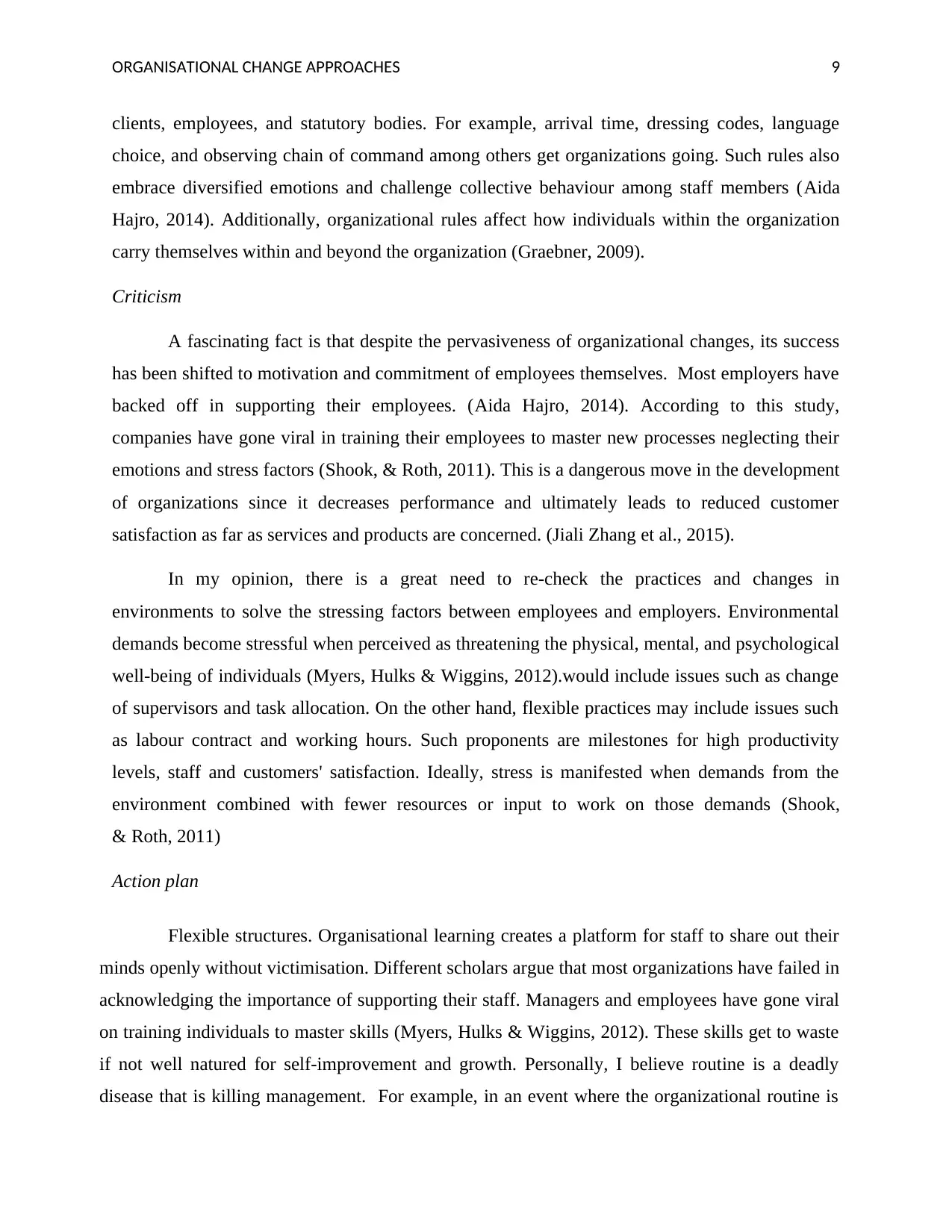
ORGANISATIONAL CHANGE APPROACHES 9
clients, employees, and statutory bodies. For example, arrival time, dressing codes, language
choice, and observing chain of command among others get organizations going. Such rules also
embrace diversified emotions and challenge collective behaviour among staff members (Aida
Hajro, 2014). Additionally, organizational rules affect how individuals within the organization
carry themselves within and beyond the organization (Graebner, 2009).
Criticism
A fascinating fact is that despite the pervasiveness of organizational changes, its success
has been shifted to motivation and commitment of employees themselves. Most employers have
backed off in supporting their employees. (Aida Hajro, 2014). According to this study,
companies have gone viral in training their employees to master new processes neglecting their
emotions and stress factors (Shook, & Roth, 2011). This is a dangerous move in the development
of organizations since it decreases performance and ultimately leads to reduced customer
satisfaction as far as services and products are concerned. (Jiali Zhang et al., 2015).
In my opinion, there is a great need to re-check the practices and changes in
environments to solve the stressing factors between employees and employers. Environmental
demands become stressful when perceived as threatening the physical, mental, and psychological
well-being of individuals (Myers, Hulks & Wiggins, 2012).would include issues such as change
of supervisors and task allocation. On the other hand, flexible practices may include issues such
as labour contract and working hours. Such proponents are milestones for high productivity
levels, staff and customers' satisfaction. Ideally, stress is manifested when demands from the
environment combined with fewer resources or input to work on those demands (Shook,
& Roth, 2011)
Action plan
Flexible structures. Organisational learning creates a platform for staff to share out their
minds openly without victimisation. Different scholars argue that most organizations have failed in
acknowledging the importance of supporting their staff. Managers and employees have gone viral
on training individuals to master skills (Myers, Hulks & Wiggins, 2012). These skills get to waste
if not well natured for self-improvement and growth. Personally, I believe routine is a deadly
disease that is killing management. For example, in an event where the organizational routine is
clients, employees, and statutory bodies. For example, arrival time, dressing codes, language
choice, and observing chain of command among others get organizations going. Such rules also
embrace diversified emotions and challenge collective behaviour among staff members (Aida
Hajro, 2014). Additionally, organizational rules affect how individuals within the organization
carry themselves within and beyond the organization (Graebner, 2009).
Criticism
A fascinating fact is that despite the pervasiveness of organizational changes, its success
has been shifted to motivation and commitment of employees themselves. Most employers have
backed off in supporting their employees. (Aida Hajro, 2014). According to this study,
companies have gone viral in training their employees to master new processes neglecting their
emotions and stress factors (Shook, & Roth, 2011). This is a dangerous move in the development
of organizations since it decreases performance and ultimately leads to reduced customer
satisfaction as far as services and products are concerned. (Jiali Zhang et al., 2015).
In my opinion, there is a great need to re-check the practices and changes in
environments to solve the stressing factors between employees and employers. Environmental
demands become stressful when perceived as threatening the physical, mental, and psychological
well-being of individuals (Myers, Hulks & Wiggins, 2012).would include issues such as change
of supervisors and task allocation. On the other hand, flexible practices may include issues such
as labour contract and working hours. Such proponents are milestones for high productivity
levels, staff and customers' satisfaction. Ideally, stress is manifested when demands from the
environment combined with fewer resources or input to work on those demands (Shook,
& Roth, 2011)
Action plan
Flexible structures. Organisational learning creates a platform for staff to share out their
minds openly without victimisation. Different scholars argue that most organizations have failed in
acknowledging the importance of supporting their staff. Managers and employees have gone viral
on training individuals to master skills (Myers, Hulks & Wiggins, 2012). These skills get to waste
if not well natured for self-improvement and growth. Personally, I believe routine is a deadly
disease that is killing management. For example, in an event where the organizational routine is
⊘ This is a preview!⊘
Do you want full access?
Subscribe today to unlock all pages.

Trusted by 1+ million students worldwide
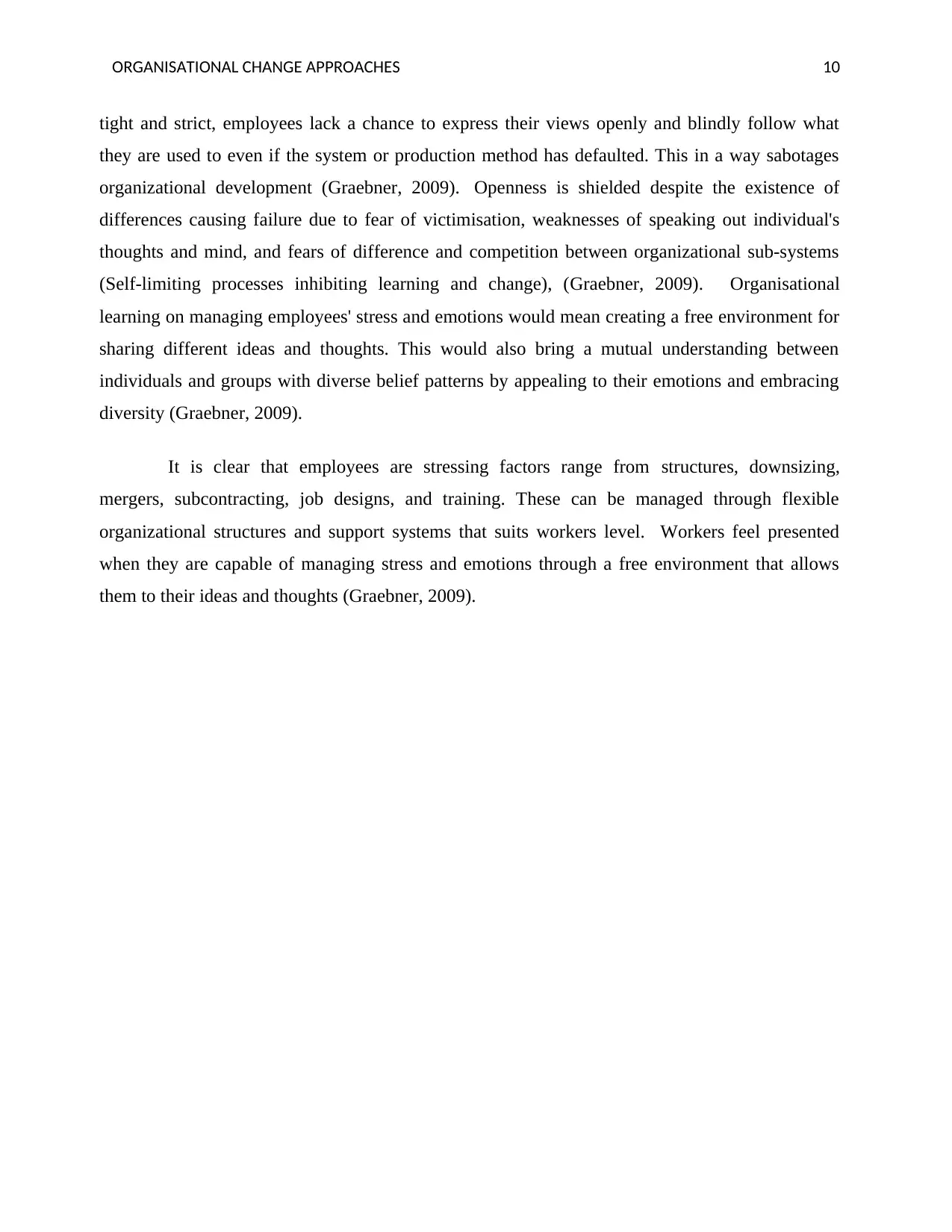
ORGANISATIONAL CHANGE APPROACHES 10
tight and strict, employees lack a chance to express their views openly and blindly follow what
they are used to even if the system or production method has defaulted. This in a way sabotages
organizational development (Graebner, 2009). Openness is shielded despite the existence of
differences causing failure due to fear of victimisation, weaknesses of speaking out individual's
thoughts and mind, and fears of difference and competition between organizational sub-systems
(Self-limiting processes inhibiting learning and change), (Graebner, 2009). Organisational
learning on managing employees' stress and emotions would mean creating a free environment for
sharing different ideas and thoughts. This would also bring a mutual understanding between
individuals and groups with diverse belief patterns by appealing to their emotions and embracing
diversity (Graebner, 2009).
It is clear that employees are stressing factors range from structures, downsizing,
mergers, subcontracting, job designs, and training. These can be managed through flexible
organizational structures and support systems that suits workers level. Workers feel presented
when they are capable of managing stress and emotions through a free environment that allows
them to their ideas and thoughts (Graebner, 2009).
tight and strict, employees lack a chance to express their views openly and blindly follow what
they are used to even if the system or production method has defaulted. This in a way sabotages
organizational development (Graebner, 2009). Openness is shielded despite the existence of
differences causing failure due to fear of victimisation, weaknesses of speaking out individual's
thoughts and mind, and fears of difference and competition between organizational sub-systems
(Self-limiting processes inhibiting learning and change), (Graebner, 2009). Organisational
learning on managing employees' stress and emotions would mean creating a free environment for
sharing different ideas and thoughts. This would also bring a mutual understanding between
individuals and groups with diverse belief patterns by appealing to their emotions and embracing
diversity (Graebner, 2009).
It is clear that employees are stressing factors range from structures, downsizing,
mergers, subcontracting, job designs, and training. These can be managed through flexible
organizational structures and support systems that suits workers level. Workers feel presented
when they are capable of managing stress and emotions through a free environment that allows
them to their ideas and thoughts (Graebner, 2009).
Paraphrase This Document
Need a fresh take? Get an instant paraphrase of this document with our AI Paraphraser
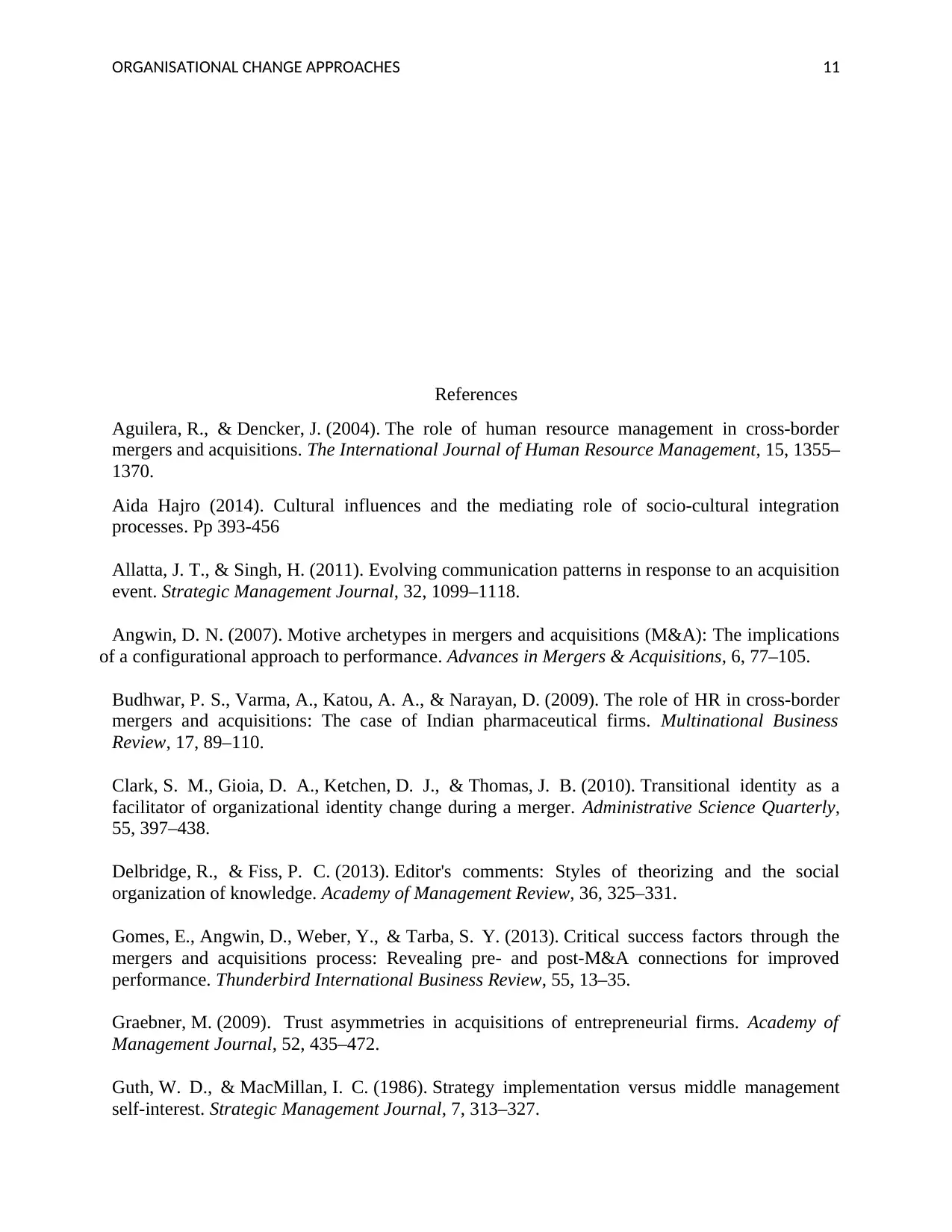
ORGANISATIONAL CHANGE APPROACHES 11
References
Aguilera, R., & Dencker, J. (2004). The role of human resource management in cross-border
mergers and acquisitions. The International Journal of Human Resource Management, 15, 1355–
1370.
Aida Hajro (2014). Cultural influences and the mediating role of socio-cultural integration
processes. Pp 393-456
Allatta, J. T., & Singh, H. (2011). Evolving communication patterns in response to an acquisition
event. Strategic Management Journal, 32, 1099–1118.
Angwin, D. N. (2007). Motive archetypes in mergers and acquisitions (M&A): The implications
of a configurational approach to performance. Advances in Mergers & Acquisitions, 6, 77–105.
Budhwar, P. S., Varma, A., Katou, A. A., & Narayan, D. (2009). The role of HR in cross-border
mergers and acquisitions: The case of Indian pharmaceutical firms. Multinational Business
Review, 17, 89–110.
Clark, S. M., Gioia, D. A., Ketchen, D. J., & Thomas, J. B. (2010). Transitional identity as a
facilitator of organizational identity change during a merger. Administrative Science Quarterly,
55, 397–438.
Delbridge, R., & Fiss, P. C. (2013). Editor's comments: Styles of theorizing and the social
organization of knowledge. Academy of Management Review, 36, 325–331.
Gomes, E., Angwin, D., Weber, Y., & Tarba, S. Y. (2013). Critical success factors through the
mergers and acquisitions process: Revealing pre- and post-M&A connections for improved
performance. Thunderbird International Business Review, 55, 13–35.
Graebner, M. (2009). Trust asymmetries in acquisitions of entrepreneurial firms. Academy of
Management Journal, 52, 435–472.
Guth, W. D., & MacMillan, I. C. (1986). Strategy implementation versus middle management
self-interest. Strategic Management Journal, 7, 313–327.
References
Aguilera, R., & Dencker, J. (2004). The role of human resource management in cross-border
mergers and acquisitions. The International Journal of Human Resource Management, 15, 1355–
1370.
Aida Hajro (2014). Cultural influences and the mediating role of socio-cultural integration
processes. Pp 393-456
Allatta, J. T., & Singh, H. (2011). Evolving communication patterns in response to an acquisition
event. Strategic Management Journal, 32, 1099–1118.
Angwin, D. N. (2007). Motive archetypes in mergers and acquisitions (M&A): The implications
of a configurational approach to performance. Advances in Mergers & Acquisitions, 6, 77–105.
Budhwar, P. S., Varma, A., Katou, A. A., & Narayan, D. (2009). The role of HR in cross-border
mergers and acquisitions: The case of Indian pharmaceutical firms. Multinational Business
Review, 17, 89–110.
Clark, S. M., Gioia, D. A., Ketchen, D. J., & Thomas, J. B. (2010). Transitional identity as a
facilitator of organizational identity change during a merger. Administrative Science Quarterly,
55, 397–438.
Delbridge, R., & Fiss, P. C. (2013). Editor's comments: Styles of theorizing and the social
organization of knowledge. Academy of Management Review, 36, 325–331.
Gomes, E., Angwin, D., Weber, Y., & Tarba, S. Y. (2013). Critical success factors through the
mergers and acquisitions process: Revealing pre- and post-M&A connections for improved
performance. Thunderbird International Business Review, 55, 13–35.
Graebner, M. (2009). Trust asymmetries in acquisitions of entrepreneurial firms. Academy of
Management Journal, 52, 435–472.
Guth, W. D., & MacMillan, I. C. (1986). Strategy implementation versus middle management
self-interest. Strategic Management Journal, 7, 313–327.
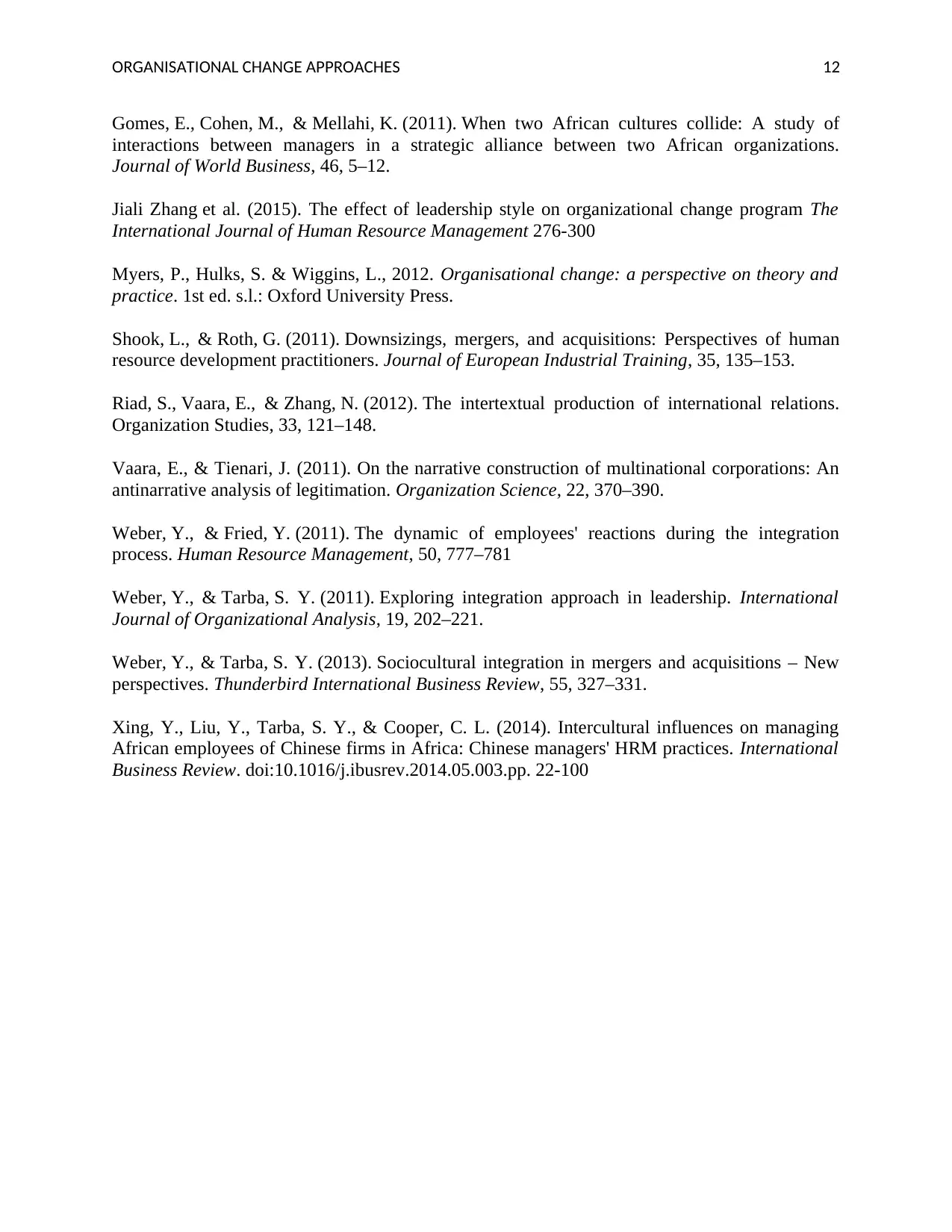
ORGANISATIONAL CHANGE APPROACHES 12
Gomes, E., Cohen, M., & Mellahi, K. (2011). When two African cultures collide: A study of
interactions between managers in a strategic alliance between two African organizations.
Journal of World Business, 46, 5–12.
Jiali Zhang et al. (2015). The effect of leadership style on organizational change program The
International Journal of Human Resource Management 276-300
Myers, P., Hulks, S. & Wiggins, L., 2012. Organisational change: a perspective on theory and
practice. 1st ed. s.l.: Oxford University Press.
Shook, L., & Roth, G. (2011). Downsizings, mergers, and acquisitions: Perspectives of human
resource development practitioners. Journal of European Industrial Training, 35, 135–153.
Riad, S., Vaara, E., & Zhang, N. (2012). The intertextual production of international relations.
Organization Studies, 33, 121–148.
Vaara, E., & Tienari, J. (2011). On the narrative construction of multinational corporations: An
antinarrative analysis of legitimation. Organization Science, 22, 370–390.
Weber, Y., & Fried, Y. (2011). The dynamic of employees' reactions during the integration
process. Human Resource Management, 50, 777–781
Weber, Y., & Tarba, S. Y. (2011). Exploring integration approach in leadership. International
Journal of Organizational Analysis, 19, 202–221.
Weber, Y., & Tarba, S. Y. (2013). Sociocultural integration in mergers and acquisitions – New
perspectives. Thunderbird International Business Review, 55, 327–331.
Xing, Y., Liu, Y., Tarba, S. Y., & Cooper, C. L. (2014). Intercultural influences on managing
African employees of Chinese firms in Africa: Chinese managers' HRM practices. International
Business Review. doi:10.1016/j.ibusrev.2014.05.003.pp. 22-100
Gomes, E., Cohen, M., & Mellahi, K. (2011). When two African cultures collide: A study of
interactions between managers in a strategic alliance between two African organizations.
Journal of World Business, 46, 5–12.
Jiali Zhang et al. (2015). The effect of leadership style on organizational change program The
International Journal of Human Resource Management 276-300
Myers, P., Hulks, S. & Wiggins, L., 2012. Organisational change: a perspective on theory and
practice. 1st ed. s.l.: Oxford University Press.
Shook, L., & Roth, G. (2011). Downsizings, mergers, and acquisitions: Perspectives of human
resource development practitioners. Journal of European Industrial Training, 35, 135–153.
Riad, S., Vaara, E., & Zhang, N. (2012). The intertextual production of international relations.
Organization Studies, 33, 121–148.
Vaara, E., & Tienari, J. (2011). On the narrative construction of multinational corporations: An
antinarrative analysis of legitimation. Organization Science, 22, 370–390.
Weber, Y., & Fried, Y. (2011). The dynamic of employees' reactions during the integration
process. Human Resource Management, 50, 777–781
Weber, Y., & Tarba, S. Y. (2011). Exploring integration approach in leadership. International
Journal of Organizational Analysis, 19, 202–221.
Weber, Y., & Tarba, S. Y. (2013). Sociocultural integration in mergers and acquisitions – New
perspectives. Thunderbird International Business Review, 55, 327–331.
Xing, Y., Liu, Y., Tarba, S. Y., & Cooper, C. L. (2014). Intercultural influences on managing
African employees of Chinese firms in Africa: Chinese managers' HRM practices. International
Business Review. doi:10.1016/j.ibusrev.2014.05.003.pp. 22-100
⊘ This is a preview!⊘
Do you want full access?
Subscribe today to unlock all pages.

Trusted by 1+ million students worldwide
1 out of 12
Related Documents
Your All-in-One AI-Powered Toolkit for Academic Success.
+13062052269
info@desklib.com
Available 24*7 on WhatsApp / Email
![[object Object]](/_next/static/media/star-bottom.7253800d.svg)
Unlock your academic potential
Copyright © 2020–2025 A2Z Services. All Rights Reserved. Developed and managed by ZUCOL.





